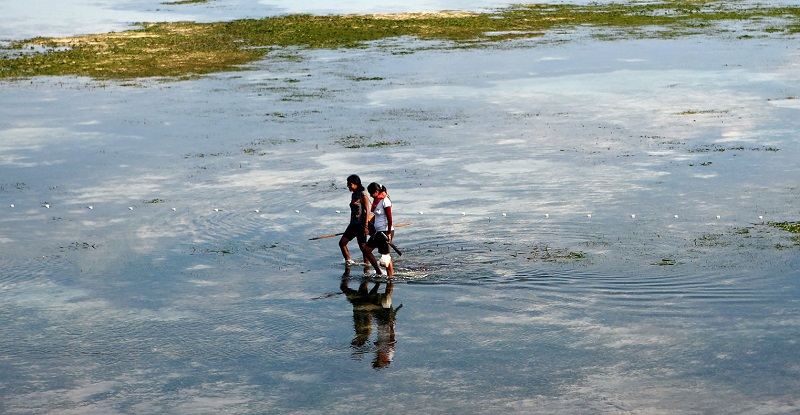Vulnerability can be defined as the lack of ability of an individual or group to anticipate, cope with, resist, and recover from the impact of natural or human-made disasters.
The impact of a disaster is similar, but unequal exposure and unequal opportunities create differences in vulnerability.
Therefore, the vulnerability of women persists and is reflected in their responses, practices, and survival during and after disasters.
Evidently, there is a need for more deliberation on the rhetoric of disasters affecting everyone equally.
Women’s vulnerability to climate and human-induced disasters varies because coping mechanisms with disasters are traditionally not gender-responsive, often increasing the burden on women without adequate support mechanisms.
Large numbers of rural women depend on climate-sensitive resources for their survival. They are also less likely to have access to education, opportunities, rights, decision-making power and resources needed to adapt to such disasters.
Women are affected mentally and physically as survivors and managers of disasters. In such situations, women’s well-being is affected by conflict, violence, and compromises at the household level.
Furthermore, temporary displacement of the household or migration of men from homes imposes additional responsibilities on women, which they have to shoulder alone.
Interestingly, the perception of disaster varies significantly between women and men, and this is mainly due to the disparity in experiences attained and responsibilities shouldered during disasters.
Therefore, it is crucial reflect on the diverse footprints triggered by inequalities and disasters and their impact on women’s vulnerabilities to climate and human induced disasters.
Women who have frequently and closely experienced floods during all its phases (pre, during and post), tend to have a deep knowledge of the problem.
Their understanding is complex and illustrative. Aspects such as inability to contribute to household income during floods; their on-the-verge existence due to insecurity and exploitation; lack of private spaces to safely perform daily personal tasks; limited personal space to accommodate other displaced family members; breakdown of local support; loss of food grains and household property; increasing debt; deteriorating health and occurrence of deaths at home, all these together have a negative impact on women.
Floods become the cause of their psychosomatic problems. Women face and deal with these complexities alone, during floods, without adequate support systems, owing to large-scale male-oriented migration from flood-prone areas.
Single women, widows, elderly women are the most vulnerable during floods.
Post floods, women play an extremely crucial role in shouldering the responsibility of structuring their return home.
It begins with the work of removing silt and mud plastering of their respective houses affected during the flood.
Plastering the house with mud is considered as a female-dominated task. All the limited savings are generally used for immediate restoration work of the damaged dwelling.
To streamline their survival after floods, women get involved in diverse tasks, such as, making cow dung cakes or collecting wood and selling them; working as agricultural labourers in the surrounding area; Putting pressure on partners to migrate to nearby areas or higher centres for additional income to the family; accessing government schemes or aid so that their immediate needs post floods are met without much compromises and external dependence.
Along with this, women also get involved in provisioning local food for the family by fishing, collecting wild spinach, snails and other locally available resources.
It is on them to source raw food materials either from the nearby market or at times from the nearest town market, in case of total absence of support within the family.
On the other hand, droughts are characterized as food scarcity, water insufficiency and paucity of livelihood, and women have a central role to play in addressing these situations.
The responsibility of running the household rests on the shoulders of non-migrant women, with increased liabilities and limited resources.
Women’s problems are further compounded during drought, as they find themselves in a new role as drought managers.
This increases the burden of meeting household needs manifold, of which ensuring water is a crucial engagement.
Accessing water for domestic chores puts an additional physical strain on women, and its impact builds pressure at the domestic front.
Shortfall in household food consumption is a direct consequence of drought-induced crop failure, and reduction of farm and non-farm-based income.
The altered status of the household, forces women to cope with the multiple scarcities by contributing as wage labourer and in curtailing food consumption.
Drought preparedness and related adaptation strategies should be designed in alliance with women, as they play a critical role during the disaster.
Drought response mechanisms, among other interventions, should be tailored to local challenges, needs and potential.
Thus, structured, and planned interventions for preparedness and adaptation to drought will possibly ease the burden of multi-tasking of women.
Further, women’s existing skills and contributions can be channeled through appropriately conceptualized government schemes and institutional interventions to stabilize and overcome financial constraints.
To support women, especially single woman, widow, and elderly woman and to address their diverse vulnerabilities, it is critical that government must develop schemes tailored to address the different disasters induced by climatic variations, with its regional and sub-regional variation.
To overcome the problem of malnutrition and anemia, consumption of nutritious food by women should be promoted.
Water security planning and practices should be conceptualized and designed in alliance with women, as access to water through local interventions will reduce the drudgery of women in drought-affected areas.
Enhancing the skills of women in managing the climatic challenges and promoting women’s collectives can be one of the ways to dispel the burden during disasters.
Climate and human induced disasters are clearly pegged at two prominent occurrences – flood and drought.
There are areas that experience both. Therefore, it is important to outline the characteristics of these occurrences in states and districts.
Unless the specificities of these phenomena are acknowledged and tackled separately, the current climate-based challenges will never be addressed or resolved.
(Eklavya Prasad is the Managing Trustee of Megh Pyne Abhiyan – A Grassroots Organization working on Water and Sanitation Issues)















